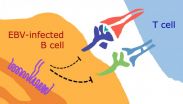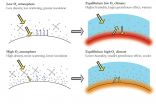(Press-News.org) Beverly, MA, June 11, 2015 - Cardiac surgeons often "crack open" the flat bone that forms the middle front section of the chest, known as the sternum, in order to reach important structures. When a sternal wound infection (SWI) occurs, serious complications and even death may result. Implanting antibiotic-laden sponges between the sternal halves before closure has been adapted to prevent infections. While a recent report questioned this practice, a meta-analysis in The Journal of Thoracic and Cardiovascular Surgery, the official publication of the American Association for Thoracic Surgery, clearly established that the sponges do work.
"The results of the meta-analysis of Kowalewski and co-workers reinforce the concept that the application of topical antibiotics to the sternum during cardiac surgery significantly reduces the incidence of sternal wound infections," commented Harold L. Lazar, MD, a cardiac surgeon at the Boston Medical Center and the Boston University School of Medicine, in an editorial accompanying the report. "Strong consideration should be given to using some form of topical antibiotics in all cardiac surgical patients undergoing median sternotomy."
In a comprehensive search of the medical literature, which followed the PRISMA guidelines to ensure the analysis was done to meet the highest standards, investigators identified 14 medium- to high-quality studies that addressed the question of implantable gentamicin-collagen sponges (ICGSs) and sternal wound infections. Of 642 potentially relevant reports, 14 met the selection criteria. These 14 studies included 22,135 patients.
The evidence was conclusive. Including both randomized and observational studies, gentamicin-collagen sponges were associated with a significant 38% reduced risk of sternal wound infections. For deep sternal wound infections, there was a 38% risk reduction compared with controls and for superficial sternal wound infections there was a 40% risk reduction. The antibiotic sponges also reduced the risk of life threatening inflammation of the mid-chest tissues (mediastinitis). The investigators noted that the use of sponges had no significant impact on mortality rate.
The authors also examined the use of the ICGS in patients undergoing bilateral internal thoracic artery (BITA) harvesting. BITA harvesting is one option to obtain grafts for patients who are undergoing coronary artery bypass grafting (CABG). This strategy provides the advantages of arterial revascularization instead of or in addition to great saphenous veins and is associated with improved survival. It is recognized though, that using both internal thoracic arteries carries a higher risk of sternal infection than harvesting a single internal thoracic artery. "We found the benefit provided by the gentamicin sponge was attenuated when BITA was harvested," said lead investigator Mariusz Kowalewski, MD, of the Department of Cardiac Surgery, Dr. Antoni Jurasz Memorial University Hospital, Bydgoszcz, and Systematic Investigation and Research on Interventions and Outcomes, Medicine Research Network (Poland). "These results suggest that another potentially preventive measure must be taken in such patients."
An impetus for this literature analysis was the publication of results from the Implantable Gentamicin Collagen Sponge on Sternal Wound Infections Following Cardiac Surgery Trial (SWIPE-1) (Bennett-Guerrero E et al, JAMA 2010;304:755-62). SWIPE-1 found no difference between IGCS and control groups for superficial SWI, deep SWI, and rehospitalization for wound infection at 90-day follow-up. The analysis by Dr. Kowalewski clearly counters the claims of the SWIPE-1 trial. "We have found that the majority of studies published so far show that the use of IGCS may significantly reduce the incidence of infectious complications after cardiac surgery," explained Dr. Kowalewski, who further noted that the SWIPE-1 results may have been due to a methodologic flaw. As Dr. Lazar added, "The results of SWIPE-1 may have been due to a failure in that trial to follow the manufacturer's sponge implantation protocol, which resulted in longer exposure of the gentamicin sponge in a saline solution before application, thus lowering the concentration of gentamicin in the sponge."
Dr. Kowalewski added that gentamicin-collagen implants are used to decrease wound infections in many other groups of surgery patients. Dr. Lazar commented that he has also found good protection against SWI with other topical antibiotics, such as vancomycin, without the emergence of drug-resistant infections or kidney problems.
INFORMATION:
Nursing home residents with dementia are less likely to be apathetic if they live in an appropriately stimulating environment, according to nursing researchers.
Nearly half of all residents in nursing homes have dementia, according to a 2013 report by the Centers for Disease Control. Apathy is one of the most common neurobehavioral symptoms in dementia, with about 90 percent of older adults with dementia experiencing it. Those with mild dementia will decline more quickly into severe dementia if they also suffer from apathy, making it important to help them stay engaged. ...
Lehigh University engineers, materials scientists and chemists will present their innovative breakthroughs to a national showcase of investors and industrial partners at the TechConnect 2015 World Innovation Conference and National Innovation Showcase in Washington on June 14-17.
Working at the junction of engineering and health, the Lehigh innovations include a nanoscale device that captures tumor cells in the blood, a bioengineered enzyme that scrubs microbial biofilms and the creation of a safe and efficient chemical reagent that is stable at room temperature.
These ...
DARIEN, Ill. -- A new study suggests that bright light at the end of a night shift may have potential as a countermeasure to improve driving performance, particularly for low light work environments and commutes that occur before dawn.
Results show that temperature, subjective alertness and psychomotor vigilance performance decreased significantly across the night. Bright light significantly suppressed melatonin, but did not improve subjective alertness or psychomotor vigilance performance. Sleep deprivation markedly increased incidents, accidents, and the average lane ...
LEXINGTON, Ky., June 12 -- In a new University of Kentucky study published today in Cell Reports, a leading scientific journal in cell biology, researchers describe a new molecular mechanism that contributes to age-related macular degeneration (AMD) due to accumulation of excessive iron within the cells of the retina.
Cells of the body use iron in dozens of normal metabolic processes. However, excessive iron or 'iron overload' can be very damaging to cells and tissues, and is implicated in numerous diseases, including AMD.
'The reason that cells die due to iron ...
About 90% of adults worldwide are infected with Epstein-Barr virus, or EBV. The virus infects B cells (the white blood cells that make antibodies) and can contribute to B-cell-derived cancers, but in most people it remains dormant--a state scientists refer to as "latent infection"--for the rest of their lives. A study published on June 11th in PLOS Pathogens sheds new light on why the infected person's immune system cannot eliminate EBV, or the associated cancer risk.
Interested in the immune response against EBV, Andreas Moosmann, from the Helmholtz-Zentrum in Munich, ...
It's difficult enough to see things in the dark, but what if you also had to hover in mid-air while tracking a flower moving in the wind? That's the challenge the hummingbird-sized hawkmoth (Manduca sexta) must overcome while feeding on the nectar of its favorite flowers.
Using high-speed infrared cameras and 3-D-printed robotic flowers, scientists have now learned how this insect juggles these complex sensing and control challenges - all while adjusting to changing light conditions. The work shows that the creatures can slow their brains to improve vision under low-light ...
ANN ARBOR--Variations in the amount of oxygen in Earth's atmosphere significantly altered global climate throughout the planet's history. Efforts to reconstruct past climates must include this previously overlooked factor, a new University of Michigan-led study concludes.
Oxygen currently comprises about 21 percent of Earth's atmosphere by volume but has varied between 10 percent and 35 percent over the past 541 million years.
In periods when oxygen levels declined, the resulting drop in atmospheric density led to increased surface evaporation, which in turn led to ...
This news release is available in Japanese.
Water injected into an inactive fault can cause aseismic slip along the fault -- movement without detectable earthquakes -- that may then indirectly lead to micro-earthquakes. That's the result from a controlled experiment by Yves Guglielmi and colleagues, who observed these events in real time after injecting fluid into a natural fault near an underground experimental facility in southeastern France. Researchers are intensely interested in this type of induced seismicity, especially with a rise in earthquakes caused by ...
This news release is available in Japanese. New experiments in the Japanese rice fish show that the fox13 gene appears to be the switch that determines whether a germ cell becomes an egg or sperm cell. The finding could help researchers learn more about how the sexual fate of germ cells is determined during vertebrate development. Toshiya Nishimura and colleagues demonstrated that fox13, which is expressed in germ cells but not in the surrounding cells of the fish's reproductive organs, provides a molecular cue that prevents the start of sperm formation. When the researchers ...
This news release is available in Japanese.
Variations in the percentage of atmospheric oxygen may have influenced climate in the past 500 million years, according to new calculations by Christopher Poulsen and colleagues. Since oxygen isn't a greenhouse gas like carbon dioxide, it typically hasn't been included in studies of past climate change. But the proportion of atmospheric oxygen has varied between 10 percent and 35 percent over the past 500 million years, and Poulsen and colleagues have developed a model to show how those fluctuations might impact climate. ...


